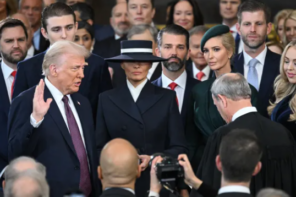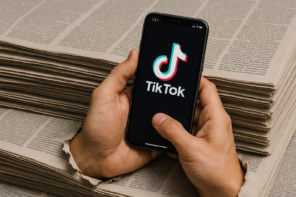
Monday October 21, 2024
Does the legacy media still shape politics in the digital age?
On 13 July 2024, the assassination attempt on Donald Trump during a campaign rally in Butler, Pennsylvania, took the internet by storm. Setting aside the countless conspiracy theories online of whether the event was staged to give the former Republican president the nearly perfect photo-op that could define the election. The picture of Trump with his fist raised in the air, with a blood-smeared face amid the background of the American flag, was on everyone’s feed. Whether you were a Republican supporter or not, social media seemed to be convinced that Trump had the election in the bag.
Yet barely a month later, the Harris campaign overshadowed Trump in media coverage and donations. This was sparked by a legacy TV debate with less than 50 million viewers when Joe Biden decided to hand over the mantle to Kamala Harris. Today, she leads most opinion polls within the US and beyond.
Why is this the case? Why is it that even in the age of hashtags and viral posts, legacy media still wields so much influence? Let’s dive into this question and look at how, despite the rise of social media, legacy media continues to drive the conversation on key policy issues—especially as we gear up for the 2024 US elections.
Mediatisation of Politics: What Does That Even Mean?
To understand the influence of media on politics, we need to talk about the concept of mediatisation. Essentially, this refers to the idea that politics and media are now deeply intertwined. In other words, politicians rely on media outlets to communicate their messages to the public, and media outlets, in turn, shape how politics is discussed and understood.
A well-known academic, Jasper Strömbäck, laid out four stages of mediatisation, the last of which is when political actors are governed by media logic. What is media logic? It’s how the media shapes and presents stories—what catches attention, entertains, and attracts clicks or viewers. This can often override political logic, which focuses on solving issues through the political process.
In this highly mediatised environment, the media doesn’t just report on political issues—it helps shape them. This is not a relatively new phenomenon; it has been the case for ages.
There are plenty of well-documented examples here in Britain to support this, such as Margaret Thatcher’s clampdown on the National Union of Journalists in the 1980s to help Murdoch move the British press from Fleet Street to Wapping, or the complete U-turn in regulating the press by Blair’s New Labour a few years later to win the favour of Murdoch’s press, in stark contrast to decades before when the party attempted to reform the press.
The Power of Legacy Media in Setting the Agenda
Let’s take the example of immigration reform, a hot topic as we approach the 2024 U.S. elections. Immigration policy is a deeply divisive issue, and while social media is full of heated debates, it’s the legacy media that often dictates which stories get attention and how they’re framed.
Fox News, for example, has focused heavily on the issue of illegal immigration, running stories on border control, security, and the migrant crisis. The framing of these stories shapes how a significant portion of the public then views issues such as immigration and, in turn, how political figures respond. Politicians often react to these narratives, creating policies that reflect what’s being discussed in the media. When legacy outlets repeatedly focus on certain issues, they drive them to the top of the political agenda, forcing the government to respond.
In fact, Biden’s recent immigration policies have come under fire after a series of media stories—some of which were critical, while others focused on humanitarian crises. The public discourse, initially sparked by legacy outlets, then spread to social media. However, the conversation usually starts with legacy media, especially when it involves national policies or debates.
Healthcare Reform: The Role of Investigative Journalism
Another area where legacy media has had a big impact is healthcare reform. Heading into the 2024 election, healthcare is once again a central issue, with debates about drug pricing and Medicare. Recently, The New York Times ran an in-depth piece about pharmaceutical companies and rising drug prices. This investigative journalism sparked new calls for legislation to cap drug costs.
While social media users quickly shared and discussed the article, it was legacy media’s reporting that first brought the issue to light, setting the stage for lawmakers to act. Despite the discussions happening on digital platforms, legacy outlets often provide the initial framework for these policy debates.
But What About Social Media? Disintermediation Explained
While social media has democratised political communication, allowing politicians to speak directly to voters and bypassing legacy media, it hasn’t completely shifted the balance of power. This process, called disintermediation, is when political actors use social media platforms to communicate with the public without filters or gatekeepers like journalists.
A great example is Donald Trump’s use of X (then Twitter) during his presidency. He didn’t need a press conference to make an announcement; he could tweet his thoughts and policies directly to millions. This allowed him to set the tone and narrative without legacy media’s involvement. His tweets during the 2020 election, for instance, sparked heated debates on everything from voter fraud to immigration.
But here’s the catch—while disintermediation allows for more direct communication, it doesn’t mean legacy media loses its influence. When politicians tweet something controversial or impactful, it’s still the legacy media that picks it up and amplifies the narrative. Even if the story starts on social media, legacy media often ends up framing the issue in a way that the public consumes more widely.
Although, this does not imply that social media has no control over setting the news agenda in any sense. Let’s step back two decades to the 2016 elections, Twitter was a key battleground for both Trump and Clinton and set precedence for political actors across the world to use social media not just for shaping public discourse but also influence legacy media.
Ironically, Trump used his Twitter handle to launch a full-fledged attack against legacy media platforms and the way they cover politics. In fact, the 2016 campaign prompted prominent outlets on the right and the left to publish unverified, scandalous content to keep up with the social media public discourse.
It would be fair to say that in today’s political landscape, legacy media and social media work together to shape public opinion. Both will continue to influence voters and attract the interest of political actors for the foreseeable future.
Why Mediatisation Still Matters
At the end of the day, politics remains highly mediatised. Even though social media has opened up new avenues for communication, legacy media still plays a critical role in setting the political agenda. This is particularly true when it comes to major policy issues.
As we head toward the 2024 U.S. elections, legacy media will keep shaping how political issues are framed, influencing both public opinion and government action. Social media may spread the message faster, but it’s the legacy outlets that are still driving the core conversations—ultimately influencing the election and government policy.
Moreover, the rise of AI, automation in communication, and the growing number of bots in our feeds highlight the need for legacy media to take on more responsibility. Authenticity and accuracy in our communications become more and more pivotal in ensuring we uphold our true democratic values.
Curzon PR is a London-based PR firm working with clients globally. If you have any questions, please feel free to contact our Business Development Team bd@curzonpr.com







Follow us